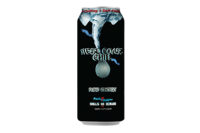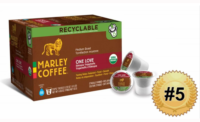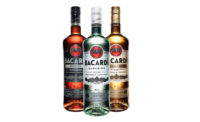Finlandia Vodka ‘Melting Ice’ Bottle
In 1970, Brown-Forman Corp., Louisville, Ky., introduced Finlandia Vodka’s “Frozen Ice” bottle, designed by Finnish designer Tapio Wirkkala. The bottle featured textured glass resembling a glittering icicle with two sparring white reindeer on the label. Between 1970 and 2011, the brand underwent multiple changes revolving around the ice theme and reindeer label. This year, it launched the “Melting Ice” bottle, which honors the original Finlandia bottle by celebrating the natural forms of ice, the company says.
The bottle takes its design from the moment before ice moves from a solid state to a liquid state, harking back to the brand’s water source. According to the company, Finlandia Vodka is made from some of the purest water in the world, sourced from the glacial ice that covered Finland 10,000 years ago.
“Ice has been the central design motif of the Finlandia brand from the beginning,” said Webb Blevins, global creative director for Brown-Forman, in a statement. “We wanted to make it a stronger element that covered 360-degrees of the bottle’s surface. But, most importantly, we wanted to improve visibility on the shelf and maintain the premium perception of the package while being true to our origins.”
Blevins led the design vision for Finlandia with help from Finnish artists; brand architects; structural designers like Harri Koskinen, a world-renowned Finnish designer who was instrumental in the development of the previous Finlandia bottle; and Kenneth Hirst, an award-winning industrial designer based in New York City, who sculpted the new bottle.
“Putting the new Finlandia package alongside any other vodka in the world shows what is possible with glass as a material,” says Neil Punwani, managing director for Finlandia Vodka. “The super-pure glass we use shows what can be achieved when the form is considered with the interaction with light: it reflects, shimmers and shines differently from each angle. The liquid looks more like it is frozen in ice than inside a bottle.”
In addition to standing out on the shelf, the bottle offers sustainability for consumers. Like all glass products, it is 100 percent recyclable. However, it differs from other vodka bottles in the market because of its artful design, the company says. This gives consumers the option to reuse the bottle as a flower vase or water carafe, Punwani said in a statement.
The bottle’s form is not the only aspect of design. The neck of the bottle now sports a sparring reindeer logo, which has appeared in some versions of the bottle since the brand’s founding. Redesigned labels also bring the Finlandia name to the forefront, ensuring better visibility on shelves and behind the bar, the company says. To help consumers differentiate between varieties, the labels incorporate the color associated with the flavor into the font and feature real fruit images accordingly.
Since the new package launched in July in the United States, the brand has seen increases in volume and market share in key markets, Punwani says.
Mio liquid water enhancers
Just when consumers embraced adding powdered drink mixes to bottles of water, Northfield, Ill.-based Kraft Foods launched a new product that changed the entire category. Mio liquid water enhancers were designed for individuals who want to personalize their beverages.
Shaped in the form of a liquid droplet, each 1.62-ounce bottle contains 24 8-ounce servings. The resealable packages enable consumers to take the product on-the-go and mix as much or as little as they’d like into a beverage. Plus, the small size makes it easy for consumers to transport. Mio is available in six flavors, each of which is denoted by the color of the graphics on the bottle.
After launching in March, Mio earned $15.5 million in sales by May 15, ranking No. 8 on Chicago-based SymphonyIRI Group’s list of the top fruit drink mix sales in total U.S. supermarkets, drug stores, gas/convenience stores and mass merchandise outlets, excluding Walmart. And as of Oct. 2, via the same parameters, the brand accrued just more than $49 million in sales, moving up to the No. 5 spot on SymphonyIRI’s list of top fruit drink mixes. Although the brand’s success cannot only be attributed to its packaging, its function provides convenience and usability for consumers — key elements of the product.
Expanding upon the successful line, Kraft Foods is in the process of launching Mio Energy, containing caffeine and vitamins B3, B6 and B12. Packaged in a smaller bottle than the original Mio line, Mio Energy comes in a 1.08-ounce bottle containing 12 8-ounce servings. It will be available in two flavors and features a black background in contrast to original Mio’s lighter background. The package’s structure and graphics aid in its findability, shelf standout and product differentiation compared to competitive products.
The Coca-Cola Co.’s PlantBottle
In April, Dasani and Odwalla brands launched nationally in The Coca-Cola Co.’s 100 percent recyclable PlantBottles. Dasani’s new packaging is made from polyethylene terephthalate (PET) plastic and up to 30 percent plant-based materials. Odwalla bottles, however, are made from up to 100 percent plant-based materials with high-density polyethylene (HDPE) plastic, which is derived from 100 percent renewable sugarcane-based ethanol.
“It’s our goal to make traditional plastic bottles a thing of the past and ensure that every beverage we produce is available in 100 percent plant-based, fully recyclable packaging,” said Scott Vitters, general manager of the PlantBottle packaging platform for The Coca-Cola Co., Atlanta, in a statement. “The national launch of Dasani PlantBottle packaging represents an important step toward reducing our carbon footprint, and the up to 100 percent plant-based, recyclable packaging used for Odwalla is the first of its kind in the beverage industry.”
The plant-based materials for both Dasani and Odwalla PlantBottle packaging are produced through a process that turns sugarcane into a key component for PET and HDPE plastic, the company says. Currently, PlantBottle packaging is made using sugarcane ethanol from Brazil, a source recognized globally for its unique environmental and social performance, the company says. Brazilian sugarcane is primarily rain-fed and industrially grown on abundant, arable land using organic fertilizers. The plantations from which PlantBottle materials are sourced are located far from Amazon rainforests and their impact on biodiversity is reduced because of advanced farming practices and sound public policy, the company adds.
Traditional PET plastic bottles are made from petroleum and other nonrenewable fossil fuels. By incorporating 30 percent plant-based materials with a blend of traditional petroleum-based materials, Dasani’s PlantBottle packaging reduces the amount of potential intrinsic carbon dioxide emissions when compared to PET plastic bottles, it adds.
Although the composition of the bottles is different from traditional plastic bottles, there are no differences in shelf life, weight, composition or appearance, and they can be recycled through existing systems, according to the company.
In late 2009, the company launched PlantBottle packaging in select markets around the world, including the western United States. In 2010, more than 2.5 billion PlantBottle packages were available across nine countries. This year, the company expects that number to have doubled to more than 5 billion PlantBottle packages in more than 15 countries.
At the time of the national launch in April, The Coca-Cola Co. estimated that the packaging had eliminated the equivalent of 30,000 metric tons of carbon dioxide, or three million gallons of gasoline used to produce PET plastic bottles. Its ultimate goal is to turn waste into a resource, resulting in a carbon neutral, 100 percent renewable, responsibly sourced bottle that is fully recyclable, the company says.
Although it’s still too early to tell, Susan Stribling, a spokesperson for Coca-Cola Refreshments, says the Dasani and Odwalla brands are seeing a positive response from the launch of PlantBottle packaging.
Seattle’s Best Coffee Level System
Research shows that shoppers today are sometimes overwhelmed by coffee choices, according to Seattle’s Best Coffee, part of Starbucks Corp., Seattle. Offering a solution, it launched its Level System of premium coffees organized by the product’s flavor boldness. Level 1 coffee is the lightest roast, while Level 5 coffee is the darkest roast. Each variety features a bold background color and large number, which aid in variety differentiation and shelf standout.
“The Level System was created to bring simplicity to premium coffee,” says Jenny McCabe, director of communication and public relations for Seattle’s Best Coffee. “The Level System uses bold, bright colors and numbers to help consumers easily find a coffee that perfectly suits their taste profile. Once consumers have found their favorite roast — their Level — the packaging design makes it easy for them to remember and find their Level the next time they are in the coffee aisle.”
In addition to Levels 1 through 5, the brand launched a decaffeinated blend, an organic Fair Trade-certified blend, a Cinnamon-flavored coffee and a Hazelnut-flavored coffee.
Before the Level System hit shelves, Seattle’s Best Coffee only offered choices in the medium and dark ranges. By expanding its variety of coffees, the brand is appealing to the growing base of consumers who enjoy a lighter blend but might be looking to trade up into the premium segment, the company says.
Less than a year after the product’s launch, company research found that the new Level System is winning over new, younger consumers. The lighter roasts (Levels 1 and 2), which appeal to mainstream coffee consumers and those new to premium coffee, have proven their appeal. In the 13 weeks ending July 9, versus the previous 52 weeks, excluding discontinued SKUs, sales of Levels 1 and 2 accounted for 16 percent of all Level sales, according to data from Nielsen, New York City. Data also showed that 30 percent of all Level purchasers were new to the Seattle’s Best Coffee brand in the eight weeks ending May 28 versus the previous 52 weeks.
The Level System is making a significant impact on the coffee aisle, McCabe says, proven by double digit sales growth that is outpacing the premium coffee category, according to Nielsen for the 13 weeks ending July 9 versus the previous 52 weeks, excluding discontinued SKUs. Seattle’s Best Coffee also has doubled distribution with key grocery and mass accounts since its launch, McCabe adds.
Craft beer in cans
Major beer companies have been offering their products in cans for years, but only recently has the trend expanded to include craft brewers.
Up until this point, craft brewers faced three challenges: Volume, equipment and consumer perception, says Dale Katechis, founder and owner of Oskar Blues Brewery, Longmont, Colo. The volume of beer made by craft brewers is much smaller than large beer makers, and at the time it was difficult to find a can manufacturer that would sell its products in such a small quantity. Plus, the production equipment was not available for craft brewers prior to 2000, he says. The last and biggest hurdle has been the consumer’s perception of beer packaged in a can.
“There were a lot of myths out there that beer tasted like metal in a can, and they were indeed just that — they were modern day myths that the consumer really did believe to be true,” Katechis says. “Once we learned that they were all myths, we decided to challenge ourselves, the industry and the consumer that you could truly put craft beer in a can and it would be even more draft-like than our colleagues that were bottling their beer at the time.”
Oskar Blues Brewery began packaging its beer in cans in 2002 after Cask Brewing Systems, Calgary, Canada, contacted them with the idea.
Recently, the industry has seen multiple craft brewers latch on to this trend. There are easily more than 100 craft brewers canning their beers and it seems that a new one is being introduced every month, says Julia Herz, craft beer program director at the Brewers Association, Boulder, Colo.
In addition to the ability to can on a smaller scale and the introduction of new equipment, craft brewers are turning to cans for their sustainability, taste and convenience benefits. And, according to Stephen Gardner, vice president of communications for The Aluminum Association, Arlington, Va., the price of cans has come down.
Aluminum cans are 100 percent recyclable and can be recycled repeatedly without loss or alteration in quality, according to Crown Holdings Inc., Philadelphia. Cans also are less expensive to ship because of their light weight, Herz says. According to Oskar Blues Brewery, the light weight of the can makes them 35 percent less fuel-consuming to ship. The brewery also notes that a recycled aluminum can generates 95 percent less pollution than one made from scratch and requires 96 percent less energy; one recycled can saves the energy equivalent of 6 ounces of gas; and cans provide full protection from light and oxygen, which can damage the taste of beer.
They’re also accepted in outdoor venues where glass bottles typically are not, and they chill more quickly than other packaging formats, according to Crown Holdings.
In response to consumers’ wariness regarding the taste of craft beer in cans, multiple craft brewers point out that the cans are coated with a water-based lining that protects and preserves the taste of the beer.
Cans also provide more printing space than bottles with traditional labels. People don’t buy craft beer just for the style, they also buy it because of the story behind the brewery, Herz says. The ability to share more of these stories with consumers is resonating with beer lovers, she adds.
In the past, cans were not seen as a premium package, however, this trend of premium beers being packaged in cans might change that perception, Gardner says. Oskar Blues Brewery, Upslope Brewing Co., Avery Brewing Co., Abita Brewing, Dundee Ales & Lagers and Narragansett Beer are just a few of the current craft brewers putting their beer in cans.
“I think we’re going to see a lot more [craft beers] move into cans,” Gardner says. BI








